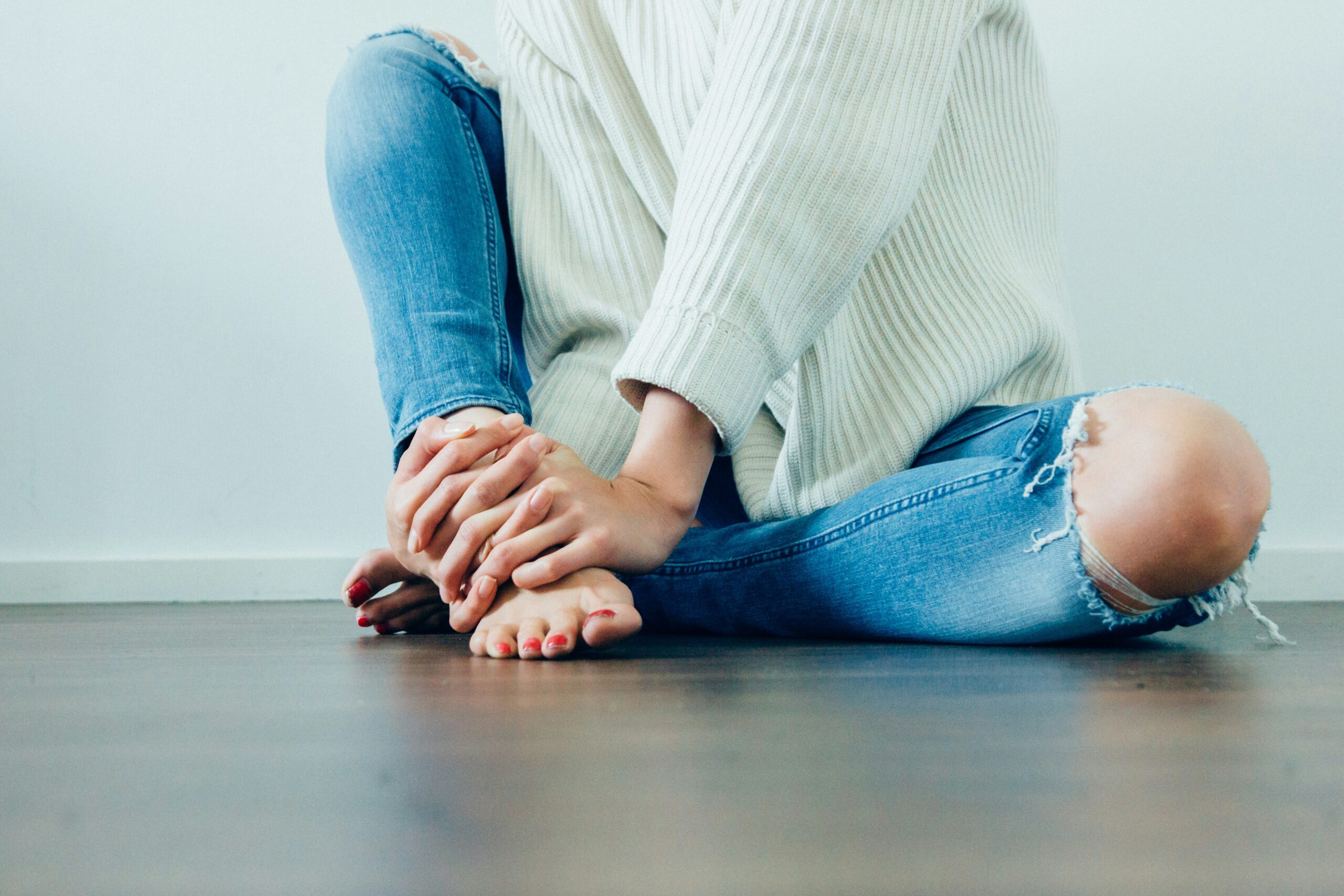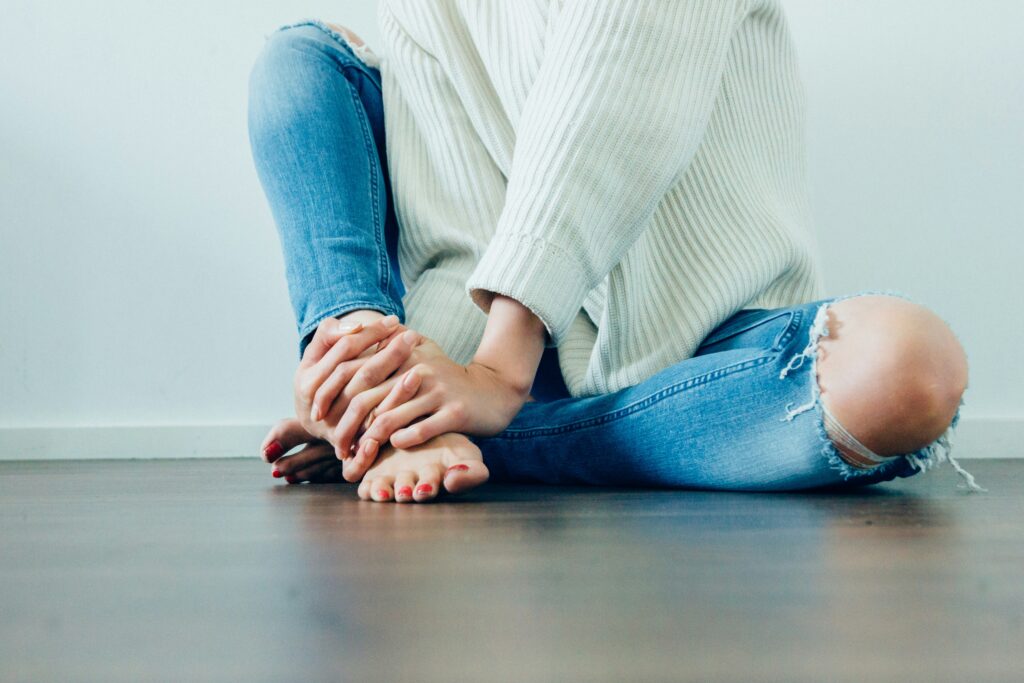
Menopause and Joint Pain – What’s The Connection & What You Can Do About It
Menopause and joint pain come hand in hand for so many women. But why? With the plethora of other menopause symptoms, do we really need to add joint pain to the list?
Here’s why joint pain is common in menopause and perimenopause and, more importantly, what you can do about it.
Last Updated:
How common is joint pain in menopause?
Menopause and joint pain are, for many women, a troublesome double act. It’s extremely common to experience joint pain in perimenopause and menopause.
While the exact figure isn’t known, some studies suggest that over 50% of women who are in perimenopause and beyond experience musculoskeletal symptoms which includes joint pain.
With that in mind, if you’ve been experiencing joint pain in perimenopause and menopause, know that many others are struggling with it, too. While that doesn’t make it feel any better, you can take comfort in knowing that you aren’t alone.
Why is menopause and joint pain linked? What causes joint pain in menopause?
What’s causing your menopause joint pain? Before we dive into how to handle menopause and joint pain, let’s take a look at why it happens.

1. Changes to your hormone levels
If you’ve read any of my other posts about menopause and perimenopause symptoms, you’ll spot a pattern here. So many of your symptoms are down to a change in hormone levels, specifically the adjustments to your oestrogen levels.
Oestrogen has a number of responsibilities and also contains anti-inflammatory properties. When your oestrogen levels change in perimenopause and menopause, this can then lead to inflammation elsewhere in the body. Not only can this cause bloating, but it also impacts your joints, causing stiffness and discomfort.
2. Weight gain can cause joint pain
Weight gain is another common symptom of menopause. The reasons vary from changing hormones, a slower metabolism, stress and comfort eating.
Weight gain can put extra pressure on your joints, specifically your knees and hips, which can then cause joint pain.
That’s why it’s so important to work on weight control in menopause and perimenopause.
3. Changes to bone density
As your oestrogen levels drop in menopause and perimenopause, your bone density can also decrease. This, in turn, elevates your risk of osteoporosis.
Osteoporosis can cause fractures and/or inflammation around your joints, which, obviously causes joint pain.
4. Natural aging
As we age, our risk of joint conditions grows, such as osteoarthritis. Natural wear and tear is to be expected as we age, which can cause cartilage breakdowns. This, as a result, is one of the key reasons menopause and joint pain are interlinked.
5. Less muscle mass
As you enter perimenopause and menopause, your risk of sarcopenia – when your muscle mass decreases and you feel weaker – increases.
Muscles are needed to support your joints, so when your muscle mass decreases, your joints are more susceptible to pain and injury.
6. A lack of physical exercise and lifestyle factors
When you’re experiencing a range of symptoms in perimenopause and menopause, it can be so tempting to avoid exercise. However, a lack of physical activity can worsen joint pain, making you feel stiffer and in more pain.
Unfortunately, this can create a vicious cycle. The more your joints hurt, the less you’ll want to exercise, worsening the state of your joints as time goes on.
What does joint pain feel like in menopause?
If you’re struggling with menopause and joint pain, you may experience the following:
- Shooting pains in your joints
- Back aches and muscle pains
- Feeling stiff in your joints
- Your joints feel swollen
- Frequent clicking, cracking and/or popping noises when your joints move
- Having less flexibility in motion
How to handle menopause and joint pain
Now we know why menopause and joint pain are linked, let’s move onto the good stuff. How can you handle joint pain in perimenopause and menopause?
1. Stay active and get your joints moving
While it may be last on the things you want to do while experiencing a bunch of other symptoms, exercise is critical to avoid joint pain in menopause.
The best exercises to aid with menopause and joint pain include:
- Yoga and pilates
- Exercises that help with flexibility and stretching. Yoga and pilates will increase your range of motion and reduce stiffness.
- Swimming, walking and cycling
- Swimming, walking and cycling are low-impact aerobic activities. Not only will these gentle exercises avoid putting too much pressure on your joints, they’re also great for heart health and often a softer, less extreme exercise to start with.
- Weight lifting and using resistance bands
- Strength training is revolutionary for many menopause symptoms. In terms of how strength training helps with joint pain, it’s all down to building muscle strength. This, in turn, helps to protect your joints.
- Tai chi
- Tai chi is a balance exercise. There are many others, too, which you can do at home. Focusing on improving balance will help you avoid falls and injury. While your joints are more vulnerable, it’s important to avoid further damage.
2. Focus on nutrition and switch up your diet
Your diet can have a huge impact on your menopause and joint pain experience. What you eat can improve or worsen your joint pain.
In terms of what to eat, it’s all about balance. A proper diet can reduce inflammation, boost general health – both physical and mental – and, ultimately, reduce menopausal joint pain.
The best foods for this include:
- Fresh fruits and vegetables
- Many fruits and vegetables contain high levels of antioxidants and polyphenols. Together, these can help to reduce inflammation.
- Berries are best and extremely versatile. Whether you’re popping them in a smoothie, scattering them on top of your breakfast or just eating them as a snack, they’re delicious and nutritious.
- In terms of vegetables, consume leafy greens such as Swiss chard, spinach, cabbage and kale.
- Whole grains in place of refined carbohydrates
- To improve joint pain, rid your refined carbohydrates and replace them with whole grains.
- Foods like brown rice, oats and quinoa will help to improve inflammation and overall joint pain.
- Omega-3 fatty acids
- Salmon, mackerel, chia seeds, walnuts and flaxseeds are packed with omega-3. Omega-3 fatty acids aid with joint pain by reducing inflammation.
- Soy foods
- Soy products contain something called isoflavones which mirror oestrogen.
- As your body contains elements that feel and behave like oestrogen, the drop in hormones doesn’t feel as drastic.
- Not only will this aid with joint pain but soy foods are fantastic for battling most menopause symptoms.
- Add tofu, edamame and tempeh to your shopping trolley and watch the impact.
- Plenty of water
- Drinking lots of water helps with so many menopause symptoms, including vaginal dryness, hot flashes and – of course – joint pain.
- Consuming water helps to keep your joints lubricated, meaning stiffness is reduced and, as a result, so is your pain.
You should avoid the following foods as they may worsen inflammation and joint pain:
- Alcohol and caffeine
- Sugar and refined flour
- Often found in sweets, pastries and cakes
- Saturated and trans fats
- Often found in red meat, processed and fried foods and butter
3. Manage your stress levels
Aches and pains in your joints can sometimes be caused by stress and anxiety. As menopause anxiety is a pretty common symptom, there is a good chance stress is worsening your joint pain.
With that in mind, it’s important to find ways to manage stress. A life without stress at all is unrealistic, so here are some ways to destress:
- Journal every evening
- Meditate
- Yoga
- Therapy
- Taking time for self-care and dedicating it to something that brings you joy
4. Lose weight
Weight gain is one of the more common contributors to why menopause and joint pain are so often experienced together.
To lose weight in menopause (and keep it off), follow these tips:
- Exercise frequently and eat strategically for weight loss
- Reduce your intake of sugar, opting for a more natural sweetness. (Take a look at my Chocolate Avocado Mousse recipe, for example.)
- Avoid alcohol and caffeine
- Let your loved ones know you are aiming to lose weight so they can support you
Menopause and joint pain – when to see a doctor
There’s no time too early to speak to a doctor if you are in discomfort. You should never feel ashamed of seeking help from a professional.
If you have continuous joint pain that interferes with everyday life, it’s critical you book an appointment with your GP. While menopause and joint pain are tightly linked, your pain may not be caused by perimenopause or menopause. It may be a signal to an underlying condition, so it’s always better to be safe.
Menopause and joint pain – in a nutshell
Menopause and joint pain often come hand in hand, caused by fluctuating hormone levels, weight gain, changes to your bone density and muscle mass and stress.
However, there are natural remedies to menopause joint pain, such as daily exercise, strategic eating, weight loss and stress management.
That said, if you’re struggling with joint pain, you should speak with a healthcare professional. They will be able to provide treatment options after ruling out any underlying conditions.
Leave a Reply
- free ebook alert -
WHAT TO EXPECT WHEN YOU’RE
going through the menopause
Demystify your understanding of what’s happening to you. Arm yourself with solid, game-changing information to support you through this challenging phase of your life.
grab your copy now →
WHAT TO EXPECT WHEN YOU’RE
going through the menopause